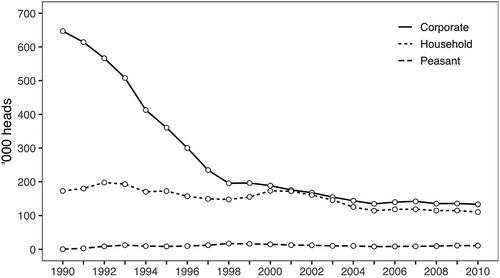ABSTRACT
Rural population decline has been observed in most developed and emerging economies but has been especially apparent in postsocialist countries. In this paper, we investigate the spatial patterns and the determinants of the rural population dynamics during the transition period from 1991 to 2010 in Tyumen Province, Russia, with the aim of better understanding the forces underlying depopulation. We use descriptive and exploratory statistical tools to analyze data from population censuses and district-level statistics of agriculture. Our results reveal distinct differences in the spatial clusters of the population increase and decline in the first and second decades of the post-Soviet era. We argue that these differences reflect the penetration of market relations into the countryside. The emergence of market forces initially advantaged the areas that were more suited to agriculture, which experienced population growth in the 1990s. Later, the drop in agricultural output, market-driven restructuring of farms, and introduction of labor-saving technologies reduced employment in agriculture. During the 2000s, labor opportunities in agriculture were no longer statistically related to rural population dynamics, while population dynamics in the villages have increasingly been determined by transport accessibility to larger markets, especially to the provincial capital. Governments need to be sensitive to these spatial and temporal population dynamics to foster opportunities in the countryside, avoid the negative side effects of depopulation on local economies and ensure the provision of social services.
Introduction
Over the past few decades, population decline has become widespread in many emerging and developed countries. In Europe, industrial regions have rapidly lost inhabitants as a result of the decay of traditional industries and due to labor-saving technological progress (Haase et al. Citation2016; Wolff and Wiechmann Citation2018). A growing income gap between prosperous metropolitan regions and the economically marginalized countryside has resulted in increasing out-migration from peripheral rural areas (Copus, Johansson, and McQuaid Citation2007; Eliasson, Westlund, and Johansson Citation2015; Lang and Görmar Citation2019; Rizzo Citation2016).
Economic polarization is especially apparent in the countries of Central and Eastern Europe, which were formerly part of the Soviet bloc. Here, the introduction of the market economy was followed by economic decline and restructuring, so after 30 years of transition, it is mainly large cities, especially national capitals, that have fully integrated into the global market and have largely caught up economically with Western Europe, while small cities and rural areas are still lagging behind (Frost and Podkorytova Citation2018; Lang and Görmar Citation2019; Leibert Citation2013; PoSCoPP Citation2015). Large cities attract rural migrants in search of better employment opportunities and higher wages.
Rural depopulation has been particularly strong in postsocialist Russia, where according to the population census of 2010, 19,500 villages (13%) were fully abandoned (Zubarevich Citation2013). Peripheral regions in the Far East, Eastern Siberia, and the Russian North lost 1.5% to 3% of their rural population every year due to out-migration between 2011 and 2015 (Nefedova and Mkrtchyan Citation2017). Rural depopulation has been a long-standing issue in Russia. In the 1960s and 1970s, the net migration losses in rural areas were approximately a million people annually (Zayonchkovskaya Citation1999). The Soviet government, concerned about the shortage of labor in agriculture, responded by investing in social infrastructure and relocating people to larger villages to prevent further out-migration (Alekseev et al. Citation2019; Pallot Citation1990). The breakup of the Soviet Union in 1991 and the following transformations resulted in a completely new political and socioeconomic context. With the start of market reforms, agricultural production declined and large areas of cultivated lands were abandoned. Farms were restructured, and the introduction of labor-saving technologies (i.e. increasing mechanization) reduced agricultural employment (Nefedova Citation2017).
Concerning the drivers of rural depopulation in post-Soviet Russia and their links to socialist legacies and the reform process following the demise of the Soviet Union, opinions vary. Some scholars focus on the effects of the neoliberal economic model and globalization on population movements in former socialist countries and stress the effects of the rising spatial inequality (see, for example, Golubchikov, Badyina, and Makhrova Citation2014; Leibert Citation2013; PoSCoPP Citation2015). Others tend to explain rural depopulation as the continuation of a long-term trend that had already started in the socialist period (see, for example, Alekseev and Safronov Citation2015; Borodina Citation2017; Zubarevich Citation2013).
This paper aims to contribute to these debates. We start with a review of the literature addressing rural depopulation from different theoretical perspectives. We complement this literature review with a statistical analysis of the spatial patterns and the determinants of the rural population change in Russia during the transition process from 1991 to 2010. We argue that these patterns and determinants were changing in response to the market-driven transformation of the rural economy. We use Tyumen Province in Western Siberia as a case study. Tyumen Province is a predominantly agricultural region with a single large city, Tyumen, as its provincial capital. Since the early 2000s, Tyumen has witnessed particularly rapid economic and population growth, while three-quarters of the rural settlements in the region have lost population.
Post-Soviet Rural Depopulation through Different Theoretical Lenses
From a long-term historical perspective, rural-urban migration can be seen as the transfer of labor from primary production to growing urban economies, reflecting the transition from an agrarian to an industrial society. This transition is facilitated by the release of labor from agriculture through technological advances and is seen as an essential component of the modernization process. This approach is closely related to the ideas of urban transition and urbanization stages (De Haas Citation2010; Skeldon Citation2012; Zelinsky Citation1971).
Soviet agriculture suffered from low efficiency and high labor intensity. State subsidies allowed agricultural enterprises to exist even in areas that had unsuitable biophysical conditions for crop or animal production (Nefedova Citation2017). In the early 1990s, when the command economy collapsed and state subsidies were withdrawn, agricultural productivity declined and agricultural enterprises were closed in many villages. Subsequently, agriculture became concentrated in areas with more productive soils and better infrastructures, while land with lower suitability was used at low intensity or even left uncultivated (Ioffe, Nefedova, and Kirsten Citation2012; Nguyen et al. Citation2018; Prishchepov et al. Citation2013). In total, 39 million hectares of sown area was abandoned in Russia between 1990 and 2010 (Lesiv et al. Citation2018). Agriculture only started to rebound in the early 2000s, accompanied by farm restructuring and the adoption of labor-saving technologies, such as more efficient machinery (Nefedova Citation2017; Rylko and Jolly Citation2005). Market-oriented large-scale agricultural companies (agroholdings) replaced the former Soviet collective farms and integrated into national and global production chains (Bogachev Citation2015). While large-scale farms increased in capital intensity but decreased in labor intensity, small, family-run farms absorbed much of the rural labor pool during the transition process (Swinnen, Dries, and Macours Citation2005). The production decline in the 1990s after the collapse of the Soviet Union led to a dramatic decrease in agricultural employment in Russia: between 1990 and 2009, the number of formal jobs in agriculture fell by one-third, mostly since the early 2000s. In particular, farm consolidation and the adoption of labor-saving technologies in the 2000s contributed to this decrease (Kalugina Citation2012; Nefedova Citation2017). In the absence of alternative sources of employment, these changes played a crucial role in accelerating rural out-migration (Nefedova and Mkrtchyan Citation2017).
While the old industrial regions and towns have been facing deindustrialization and job losses since the start of the transition, the ongoing rural-urban migration has been fueling postindustrial development in large Russian cities. Modernization theory suggests that, at some later point in time, economic growth and the subsequent inflow of population will also spread to smaller centers, for example, through the growth of suburbs and the development of network cities, such as those seen in Western countries (Nefedova and Treivish Citation2019).
Path dependency may be one explanation for rural depopulation. Path dependency focuses on structural constraints that result in a lock-in situation preventing the regeneration of depopulated regions. Path dependency can occur because of a feedback loop between migration and natural growth. Most young and active people trade the countryside for cities (Kashnitsky Citation2020; Taylor and Martin Citation2001). The older rural population remains behind, which in turn, leads to decreasing birth rates and growing mortality and hence to an additional population decline. For example, in Central Russia, between 1959 and 1989, the population density in the countryside fell by more than half (Lukhmanov Citation2001). None of the regions that lost population in the late Soviet period experienced population growth after the collapse of the Soviet Union, while the regions that are growing now were also gaining population before 1991 (Borodina Citation2017).
The links between migration and natural population change are part of the causal chains that define the cumulative effects of depopulation. These effects were first described by Myrdal as cumulative causation (Myrdal Citation1957). The decline in agricultural employment, for example, can be seen not only as a cause of rural out-migration but also as a consequence: because of the selectivity of migration, the number of potential employees in rural areas drops. This drop in potential employees affects local industries that then leave the depopulating regions due to the increasing shortfall in qualified labor. Falling demand for goods and services jeopardizes local trade and service provision. Local tax income declines in response, contributing to the further degradation of the social infrastructure. From 2000 to 2010, the number of schools and hospital beds in Russia decreased by 26% and 20%, respectively, mostly in rural areas and in shrinking small cities (Zubarevich Citation2013). Young people have little motivation to stay in the countryside, as work in agriculture is becoming less prestigious and provides lower income than urban employment (Unay‐Gailhard et al. Citation2019). Thus, rural depopulation appears to be a cumulative process resulting from deepening sociospatial inequalities due to the loss of human capital through out-migration (Goss and Lindquist Citation1995).
The new economic geography complements cumulative causation theory by stressing the role of agglomeration effects and transport costs as the key determinants of spatial polarization. With falling transport costs, economic activities tend to concentrate in large cities, where companies take advantage of a larger market, better suppliers, qualified labor, and knowledge spillovers (Krugman Citation1991, Citation1993). Even a small change in transport costs and the fall of economic parameters below a critical level can trigger a rapid redistribution of economic activities and population so that larger cities grow at the expense of smaller cities, even if the difference between them is initially very small (Krugman Citation1991). Cumulative causation theory argues that capitalist development is inevitably marked by deepening spatial inequalities. Once differential growth has occurred, internal and external economies of scale deepen it through a vicious cycle of poverty in the periphery and accelerated growth in the core region (De Haas Citation2010).
Soviet Russia was a rapidly polarizing and fragmented society. Forced urbanization during the Soviet period resulted in Russia’s swift shift from being a predominantly agrarian country to the “land of great cities” (Harris Citation1945), where 42% of the urban population resided in cities with a population of at least 500,000 people in 1989, including 8.7 million people in Moscow (Shcherbakova Citation2010). The dominance of large cities reflected the centralized government, which focused on ensuring a sufficient labor supply for heavy industries and the huge areas of inhospitable, uncultivated wilderness, especially Siberia. Some argue that the country was “over-industrialized” and “over-urbanized” (Tsenkova Citation2006). Large-scale production also dominated the rural economy. Many large villages were home to state agricultural enterprises but also supported agricultural industries, such as brickmaking and machinery repair; the commercial sector; public administration; and social infrastructures, such as schools and kindergartens, post offices, and cultural amenities. Small villages were treated as “nonprospective” and were often abandoned (Alekseev et al. Citation2019), which resulted in a very centralized and hierarchical settlement system. The Soviet plan aimed at smoothing the socioeconomic differences among regions but eventually produced a space fragmented by administrative units, i.e. by provinces (“oblasts”) and districts (“rayons”), with distinct socioeconomic contrasts between administrative and productive centers on the one hand and ordinary villages on the other (Kagansky Citation2001). Not surprisingly, with the transition to a market economy, these contrasts intensified and fostered the outflow of people from the peripheries. Golubchikov, Badyina, and Makhrova (Citation2014) argue that the market transition should be seen not as a movement from a “more socialist” to a “more capitalist” society but as an active process in which socialist legacies were alienated from their ideological and institutional history and were embedded in the matrix of capitalist relationships. If a growing spatial inequality is a distinct feature of the capitalist mode of production, then state socialism prepared the grounds for it.
A drawback of the theory of cumulative causation lies in the controversy surrounding the pessimistic scenario it draws, where the self-reinforcing cyclical mechanisms of polarizing development go on infinitely, which seems unrealistic (De Haas Citation2010). The theory overestimates the role of structural constraints, thus denying the ability of people to change structures and reverse trends. Studies show that the rise of informal employment and various forms of social innovations, such as private preschools and local community centers, have helped to mitigate the drop in employment in the corporate sector and the degradation of the state social infrastructure in the depopulated countryside in post-Soviet Russia (Averkieva Citation2012; Granberg and Sätre Citation2016).
The cumulative causation theory has also been criticized for its deterministic view of center–periphery relations. The economic problems of the periphery stem not only from its geographical remoteness from centers or the differences in market sizes but also from the design of public institutions. Peripheries are socially produced through unequal power relations and unequal access to development resources (Kühn Citation2015). Neither centers nor peripheries can be seen as static concepts with naturally given boundaries. Peripheralization stands as a dynamic process that can be reversed or redirected (Lang Citation2015).
Peripheralization also means a growing inequality among rural settlements. The uneven development of agriculture, possible changes in the hierarchy of central places, and reallocation of economic activities after the breakup of the Soviet Union affected the willingness of people to stay or to move and produced perceptible spatial patterns of population change in the countryside. Investigating these patterns, understanding why some rural settlements were losing population while others were not, is key for understanding the driving forces behind depopulation in general.
Most studies stress that the rural population dynamics in postsocialist Russia have been largely determined by 1) the initial size of settlements, with larger villages having a larger “market potential” and hence more stable population numbers; 2) the bioclimatic conditions, with settlements in areas with a favorable climate and fertile soil having better opportunities in the market economy to specialize in agriculture and increase production efficiency; and 3) the accessibility to cities, with periurban settlements being able to leverage their access to cities’ superior labor markets, wages, education, and services (see, for example, Gunko and Glezer Citation2015; Ioffe and Nefedova Citation1999; Karachurina and Mkrtchyan Citation2016). This paper aims to broaden current knowledge by addressing the evolution of the spatial patterns and determinants of rural depopulation under the political and socioeconomic transformations that have occurred since 1990.
Materials and Methods
Study Area
The majority of research on rural depopulation in Russia addresses the regions in the European part of the country, especially the non-Chernozem regions whose demographics, starting from the 19th century, have been strongly influenced by the growth of Moscow and Saint Petersburg. Here, we focus on Tyumen Province, which is a more peripheral and less urbanized area that has experienced significant population outflow from the countryside since the mid-20th century.
Tyumen Province is located to the east of the Ural Mountains in Asian Russia and covers 160,000 km2 (). In comparison with European countries, this area roughly corresponds to the combined area of the Czech Republic and Austria, which have a combined population of 20 million people, while the population of Tyumen Province in 2020 was 1.5 million people. The region has 1,200 settlements, which are organized into 22 municipal districts (“rayons”), with three main urban centers: the provincial capital Tyumen (807,000 inhabitants in 2020), Tobolsk (102,000 inhabitants), and Ishim (64,000 inhabitants) (). Half a million people (33% of the provincial population) reside in rural areas.
Figure 1. Ecozones (Olson et al. Citation2001), rivers, settlements, and major transport routes in the study area

The region has historically been dominated by agriculture. The southern districts of this region are located in forest-steppe and pretaiga (hemiboreal forests) ecozones (see ) and form part of the Western Siberian grain belt (Kühling, Broll, and Trautz Citation2016). In the northern forest areas, agriculture has been dominated by cattle farming. Since the 1960s, the development of oil and gas production in the northern parts of Western SiberiaFootnote1 fostered the growth of the capital city Tyumen, which became a home for industries and services supportive of the fossil fuel industry.
In the late Soviet period, the rural population of Tyumen Province decreased from 600,000 in 1959 to 500,000 in 1989 (Tyumenstat Citation1983). This decrease was accompanied by a sharp decline in the number of settlements, especially in the northern forested areas that were dominated by small riverine villages with no more than a hundred inhabitants. Between 1971 and 1991, 340 villages (one-fifth of all rural settlements) were abandoned (Tyumenstat Citation1983, Citation1991). People mainly moved to nearby larger villages and to urban-type settlements (“poselki”), which served as local administrative centers and received government investments.
The post-Soviet population dynamics in the region largely followed the pattern observed in other regions of Russia. The first years of the transition witnessed a reverse in the population trends caused by the deindustrialization and in-migration of ethnic Russians from other Soviet republics after the demise of the Soviet Union (Heleniak Citation1999; Ioffe and Nefedova Citation1999). However, the rural population decline resumed after 1995 (). By 2010, 969 (74%) of the 1,305 settlements that existed in Tyumen Province in 1990 had experienced a population decrease, while 84 villages had been fully abandoned. Of the 1,203 remaining settlements, 412 (32%) had fewer than 100 inhabitants.
Figure 2. Total population of Tyumen Province, 1981–2018

Since the mid-2000s, Tyumen has witnessed rapid economic growth due to increasing oil prices and tax incomes. In response, the population of Tyumen city increased by 1.6 times between 2004 and 2020.
Investigating Spatial Patterns of Rural Population Dynamics and their Determinants
To investigate the patterns of the rural population dynamics in Tyumen Province, we used data from the Russia-wide population censuses of 2002 and 2010 (Rosstat Citation2013) and from regional statistical committee bulletins (1990). We labeled the periods between the censuses as the early (1990 to 2002) and late (2002 to 2010) transition periods. We mapped the population changes in individual settlements for each of the two periods and then compared the hotspots of population increases and declines.
To define the role of agriculture in determining rural population dynamics, we analyzed the structural changes in agricultural production in Tyumen Province after the breakup of the Soviet Union and compared the data on formal agricultural employment from the 2006 national agricultural census (Tyumenstat Citation2008) with the population dynamics in municipal districts (rayons) between 2002 and 2010 (Tyumenstat Citation2020).
To study the determinants of depopulation, we modeled population changes in individual settlements as a function of 1) the size of the settlement and 2) its location relative to the provincial capital and to the rayon administrative center in a linear mixed-effects regression framework. The proportion of the settlement’s initial population at the end of the respective period served as the dependent variable. The covariates were the log of the initial population and the shortest road distances (in kilometers) to Tyumen and to the rayon center. The distances were calculated using the OpenStreetMap road network (OpenStreetMap contributors Citation2018). The observations beyond three median absolute deviations (median(|X–median(X)|) were treated as outliers and excluded from the analysis (113 observations or 4.4% of the total); these were very small villages where changes of a few people produced large percentage values. We also excluded settlements that lost their official status as a result of administrative changes (13 observations or 0.5% of the total). We used “rayons” (districts) as a grouping variable so that we could distinguish the effects of the inter-rayon differences from the effects of village size and location. We tested models with random intercepts (in which the rayons differed in average population changes) and models with both random intercepts and random slopes (in which the rayons differed in average population changes and in the effects of accessibility and size). To compare the fit of the models, we used the Akaike information criterion (AIC). We built separate models for each study period (1990 to 2002 and 2002 to 2010) to examine how the effect sizes of the determinants changed over time.
All the analyzes were conducted in R (R Core Team Citation2018). The models were fitted using the package lme4 (Bates et al. Citation2015), and plots were created with ggplot2 (Wickham Citation2016). in the Appendix contains the descriptive statistics for the dependent and independent variables.
Results
Spatial Patterns of Rural Population Dynamics
We found a clear spatial division between growing and shrinking settlements, albeit with pronounced differences, in the early and late transition periods (). In the 1990s, the overall picture of the population dynamics was highly diverse. There were rapidly shrinking settlements but also rapidly growing settlements. In contrast to the Soviet period, the population dynamics we observed went against the center-periphery logic in many cases, with administrative centers losing people and neighboring villages growing in size. Overall, 927 (71%) of 1,305 settlements (including cities) were shrinking. The hotspots for rural population growth were historically established agricultural regions near the cities of Tyumen and Ishim and along the Trans-Siberian Railroad (cf. ). The taiga part of the region was largely losing people, with the exception of villages with an ethnically non-Russian population.Footnote2
Figure 3. Patterns of population change in Tyumen Province (the circle size indicates the initial size of the population, while the colors signal changes in population)
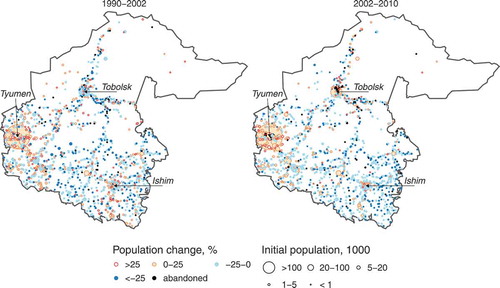
From 2002 to 2010, the number of shrinking settlements increased to 975 (76%) out of 1,273, while the spatial patterns of population growth and decline changed profoundly: the rural population increasingly concentrated in the cities’ surrounding settlements, especially around the provincial capital. The hotspots for rural population growth in established agricultural regions from the previous period shrank or disappeared. Most of the settlements beyond the metropolitan areas, except for the administrative centers of the rayons, lost population. Thus, although depopulation prevailed in most of the province during both the early and late transition periods, the spatial patterns of the population dynamics differed significantly.
The Role of Agriculture in Driving Rural Population Dynamics
The start of the market reforms was followed by a decline in agricultural production. Many of the crop-growing enterprises persisted after the breakup of the Soviet Union in different organizational forms (Griewald Citation2018), while the sown area across the province decreased by approximately 35% between 1990 and 2015, largely in the northern forest areas and in the south, which had wet soils that were difficult to access and work (Nguyen et al. Citation2018; Sheludkov Citation2019). The fall of the numbers of cattle reached 70% of the 1990 number in 2005–2010 (see in the Appendix). The decline in cattle primarily affected the corporate sector so that by the early 2000s, half the livestock in the region were in private households (see in the Appendix).
The transition has widened the gap between the more- and less-agriculturally prosperous rayons. According to the first post-Soviet agricultural census in 2006, agricultural companies and commercially oriented family farms provided 44,000 jobs and employed 11% of the working-age population in the rural districts of Tyumen Province. A total of 34,500 people were directly involved in agricultural production activities; among them, 7,000 and 4,200 people were in the Tyumen and Ishim rayons, respectively ().
Figure 4. Number of people (a) and share of the working-age population (b) involved in agrarian production in agricultural enterprises and commercially oriented family farms in 2006
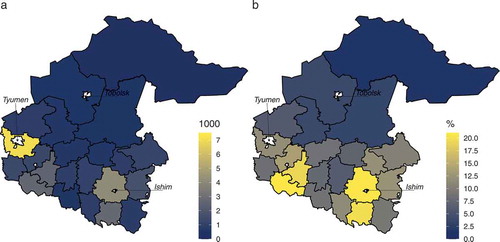
The rayons with more agricultural employment in 2006 correspond to the areas of rural population growth during the first post-Soviet decade (cf. ). However, a comparison between the proportions of the working-age population involved in production in agricultural enterprises and commercially oriented family farms in 2006 and the changes in population numbers in the rayons from 2002 to 2010 revealed no significant relationship (Spearman’s rho: Z = −1.167, p-value = 0.26). These results suggest that by the mid-2000s, the decline in agricultural employment was strong enough for agriculture to lose its power to shaped rural population dynamics, at least at the level of rayons. In the following ten years, the decline in formal employment continued, so by 2016, the number of people working for agricultural companies and commercial family farms in Tyumen Province had fallen to 22,500, from approximately 70,000 in 1990 (Belonozhko Citation1998; Tyumenstat Citation2019).
The Effects of Settlement Size and Geographical Remoteness on Population Dynamics
The regression results show that the initial size of a settlement has a strong positive effect on its population dynamics: the larger the village, the lower the probability that it lost people. The effect did not change from the early to the late transition period (). The dynamics of population change in individual settlements was increasingly dependent on the geographical position relative to the provincial capital and rayon administrative centers.
Table 1. Results of the linear mixed-effects model with the percent of the initial population at the end of the period as the dependent variable
From 1990 to 2002, the village population decreased by 0.07% and by 1.01% for every 10 km away from Tyumen and from the rayon center (). The compound effect of accessibility to cities and rayon centers showed a wave-like development with overlapping ups and downs (). The increasing distance from Tyumen was compensated for by proximity to other cities or to rayon centers. Settlements that were peripheral at both the regional and rayon levels experienced the strongest depopulation.
Figure 5. Population change in individual settlements plotted as a function of distance to the regional capital
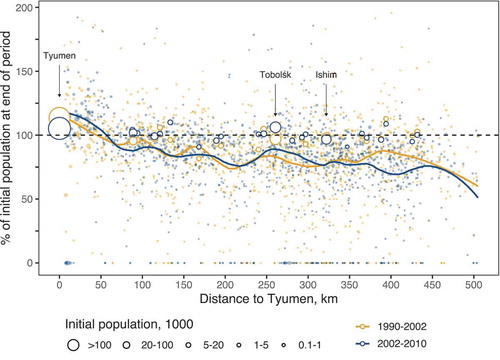
For the period from 2002 to 2010, for every 10 km further from Tyumen and the rayon center, the population declined by 0.39% and 1.38%, respectively. These figures are 5.6 and 1.4 times greater than the declines in the first intercensal period (cf. ). The explanatory power was greater for the second period model (first period: marginal R2 = 0.26, second period: marginal R2 = 0.15), mainly because of the stronger dependence of the population dynamics on the transport accessibility to cities and rayon centers. The accuracy (predictive power) was also higher for the second period than for the first period (first period: root mean square deviation = 26, second period: root mean square deviation = 21.5).Footnote3
Discussion
Our results demonstrate how against the background of the decreasing agricultural employment in the first two post-Soviet decades, the population dynamics in towns and villages of Tyumen Province were increasingly conditioned by transport accessibility to major markets. We argue that the changing spatiotemporal patterns of rural population dynamics reflect the penetration of capitalist economic relations into the Russian countryside.
The emergence of market forces first advantaged areas with better agricultural conditions, so in the early period (1990–2002), pockets of rural population growth were observed in the old agricultural regions in the west and southeast of Tyumen Province as well as around its cities and along major routes. This is unlike the situation during the Soviet period, when the population dynamics in the countryside were mostly determined by the administrative status of the settlements.
With the involvement of remote rural areas in regional and national markets, cheaper and often higher-quality goods that are produced in cities displaced local manufacturers in rural areas (Lasanta et al. Citation2017; Wiggins and Proctor Citation2001). It took a decade in Russia for the new institutional settings, novel agents, and altered market conditions to affect agricultural employment while providing new jobs in cities. The new economic strategies, technologies, and organizational forms spread toward the countryside with new market-oriented agents, such as agroholdings. These agents were very different from the former Soviet enterprises in terms of resources, strategies, and social responsibility; they facilitated the adoption of labor-saving technologies (Fadeeva Citation2015; Nefedova Citation2017; Nikulin Citation2010). As our findings show, agriculture in the 2000s was no longer able to provide rural areas with the formal employment opportunities that were needed to halt population decline. In this period (2002–2010), large-scale depopulation became evident in most of the countryside beyond the metropolitan areas, except in the largest settlements. The population dynamics in individual villages have become increasingly determined by their geographical position relative to larger markets. As we observe, transport accessibility to cities and to rayon centers became increasingly paramount for explaining the patterns of rural population change. This situation leaves little hope for remote and smaller villages and towns that will likely continue to shrink and also foregrounds the Soviet legacies since the administrative hierarchy of rural settlements (and accordingly, their population size), the centralized governance, the location of social services and enterprises, and the transport accessibility of the villages trace back to the socialist period.
Tyumen Province is a wealthy region by Russian standards, and its gross domestic product per capita is in the top 10 among all Russian provinces. The high tax incomes from oil and gas production provide the Tyumen government with the resources to maintain social infrastructure in the countryside and support agricultural development. At the same time, the rapid development of the urban economy makes the provincial capital more attractive to migrants from rural areas. In other regions with different budget resources, natural resources, and population densities, the demographic changes and their determinants might be very different from the results we obtained for Tyumen Province. Nevertheless, our findings reveal trends that are common for the market-driven transformation of the countryside in Russia, as the structural changes of the post-Soviet era had a similar shape in most of the regions.
The outflow of people from rural areas is a major challenge for regional policies and planning in Russia, which still strongly relies on the practices of the Soviet period and requires new approaches to deal with depopulation (Batunova and Gunko Citation2018; Kinossian Citation2013). In neoclassical economics, migration is seen as an adjustment mechanism that helps to smooth disparities among regions (Hazans Citation2003). In times of economic restructuring – when existing jobs are lost and new sectors and companies emerge – reallocation of labor facilitates economic development and results in a new equilibrium (Greenaway, Upward, and Wright Citation2000; Martynovich and Lundquist Citation2016; Pastore Citation2012). However, continuous out-migration from a region can trigger a chain of undesired changes. The loss of qualified workers and consumers undermines local economies. Reduced budgets through lower local tax revenue jeopardize the provision of social infrastructure and public services (Naumann and Reichert-Schick Citation2013; Zubarevich Citation2013). Depopulation also involves the loss of cultural landscapes and is often associated with a loss of biodiversity and ecosystem functions, including in our study area (Kamp et al. Citation2018). Governments need to be sensitive to the observed population dynamics and find strategies that balance negative and positive consequences and are directed toward raising the opportunities in the countryside.
Due to a lack of data, we were not able to account for informal agricultural employment, which has arguably mitigated the drop in employment in the commercial sector and provided crucial livelihood contributions when formal jobs were absent. As no statistics exist on informal agricultural employment, which is mainly small-scale and partly subsistence-oriented, incorporating informal agriculture necessitates self-collected primary data, which was beyond the scope of this research. Nevertheless, we believe that promoting small-scale family farming is one way of dealing with rural depopulation along with the development of forestry, tourism, and other industries that are based on immobile production factors or resources (Wiggins and Proctor Citation2001). In sum, our results shed light on the fundamental population changes in Russia’s countryside and call for an increasing sensitivity of the national and regional governments to these spatial and temporal population dynamics. Only then can governments formulate well-targeted policies that foster the opportunities inherent in population changes and avoid their negative side effects for local economies and the provision of social services.
Acknowledgments
The authors thank Lilia Martens for collating the agricultural statistics data.
Disclosure statement
No potential conflict of interest was reported by the authors.
Additional information
Funding
Notes
1. Khanty-Mansiysk and Yamalo-Nenets autonomous districts.
2. Siberian Tatars are the native population of Tyumen Province. They live in remote villages in the northern forest rayons and are engaged in traditional economic activities such as fishing and wild berry picking.
3. Figures , , , and in the supplementary material show the actual and predicted values of population dynamics relative to the distance to Tyumen and rayon centers.
References
- Alekseev, A. I., and S. G. Safronov. 2015. “Transformation Trends of Russia’s Rural Settlement Patterns in the Late Soviet and post-Soviet Periods (1970–2010).” Regional Research of Russia 5 (2): 193–201. doi:10.1134/S2079970515020021.
- Alekseev, A. I., S. G. Safronov, M. S. Savoskul, and G. Y. Kuznetsova. 2019. “Osnovnye Tendentsii Evolyutsii Sel’skogo Rasseleniya Rossii V XX – Nachale XXI Vv. [The Main Trends in the Evolution of Rural Settlement in Russia in the XX – Early XXI Centuries].” EKO 49 (4): 26–49. doi:10.30680/ECO0131-7652-2019-4-26-49.
- Averkieva, K. V. 2012. The Geography of Adaptation Processes in the Rural Non-Chernozem Region at the Turn of the XX – XXI Centuries. Cand. Sci. (Geogr.) diss: Moscow State University.
- Bates, D., M. Mächler, B. Bolker, and S. Walker. 2015. “Fitting Linear Mixed-Effects Models Using Lme4.” Journal of Statistical Software 67 (1): 1–48. doi:10.18637/jss.v067.i01.
- Batunova, E., and M. Gunko. 2018. “Urban Shrinkage: An Unspoken Challenge of Spatial Planning in Russian Small and Medium-Sized Cities.” European Planning Studies 26 (8): 1580–1597. doi:10.1080/09654313.2018.1484891.
- Belonozhko, M. L. 1998. Agrarnye Reformy V Tyumenskom Regione: Sovremennost’ I Prognoz [Agrarian Reforms in Tyumen Province: Present State and Forecast]. Tyumen: Vektor-Buk Publ.
- Bogachev, D. V. 2015. “Transformation of the Agriculture in Russia: Significance of Present-Day Vertical Integration.” Regional Research of Russia 5 (4): 392–401. doi:10.1134/S2079970515040073.
- Borodina, T. L. 2017. “Regional Features of Population Dynamics in Russia in the post-Soviet Period.” Regional Research of Russia 7 (1): 10–22. doi:10.1134/S2079970517010014.
- Copus, A. K., M. Johansson, and R. W. McQuaid. 2007. “One Size Fits All? Regional Differentiation and Rural Development Policy Un moule unique? Différenciation régionale et politiques de développement rural Sind alle Regionen gleich? Regionalen Differenzierung und die Politik zur Entwicklung des ländlichen R.” EuroChoices 6 (3): 13–21. doi:10.1111/j.1746-692X.2007.00070.x.
- De Haas, H. 2010. “Migration and Development: A Theoretical Perspective.” International Migration Review 44 (1): 227–264. doi:10.1111/j.1747-7379.2009.00804.x.
- Eliasson, K., H. Westlund, and M. Johansson. 2015. “Determinants of Net Migration to Rural Areas, and the Impacts of Migration on Rural Labor Markets and self-Employment in Rural Sweden.” European Planning Studies 23 (4): 693–709. doi:10.1080/09654313.2014.945814.
- Fadeeva, O. P. 2015. Sel’skie Soobshchestva I Khozyaistvennye Uklady: Ot Vyzhivaniya K Razvitiyu [Rural Communities and Households: From Survival to Development]. Novosibirsk: IEOPP SO RAN.
- Frost, I., and M. Podkorytova. 2018. “Former Soviet Cities in Globalization: An Intraregional Perspective on Interurban Relations through Networks of Global Service Firms.” Eurasian Geography and Economics 59 (1): 98–125. doi:10.1080/15387216.2018.1506995.
- Golubchikov, O., A. Badyina, and A. Makhrova. 2014. “The Hybrid Spatialities of Transition: Capitalism, Legacy and Uneven Urban Economic Restructuring.” Urban Studies 51 (4): 617–633. doi:10.1177/0042098013493022.
- Goss, J., and B. Lindquist. 1995. “Conceptualizing International Labor Migration: A Structuration Perspective.” International Migration Review 29 (2): 317–351. doi:10.1177/019791839502900201.
- Granberg, L., and A. M. Sätre. 2016. The Other Russia: Local Experience and Societal Change. London: Taylor & Francis.
- Greenaway, D., R. Upward, and P. Wright. 2000. “Sectoral Transformation and Labor-Market Flows.” Oxford Review of Economic Policy 16 (3): 57–75. doi:10.1093/oxrep/16.3.57.
- Griewald, Y. 2018. “The Art of the State to Intervene: Insights into Agricultural Land Management in Russia.” Ecological Economics 151: 1–9. doi:10.1016/j.ecolecon.2018.04.026.
- Gunko, M. S., and O. B. Glezer. 2015. “Malye Raionnye Tsentry I Okruzhayushchie Territorii V TSentral’noi Rossii V 1970–2010 Gg.: Dinamika I Raspredelenie Naseleniya [Small District Centers and the Surrounding Areas in Central Russia (1970–2010): Dynamics and Distribution of Population].” Izvestiya Akademii Nauk, Seriya Geograficheskaya 1 (1): 64–76. doi:10.15356/0373-2444-2015-1-64-76.
- Haase, A., M. Bernt, K. Großmann, V. Mykhnenko, and D. Rink. 2016. “Varieties of Shrinkage in European Cities.” European Urban and Regional Studies 23 (1): 86–102. doi:10.1177/0969776413481985.
- Harris, C. D. 1945. “The Cities of the Soviet Union.” Geographical Review 35 (1): 107–121. doi:10.2307/210935.
- Hazans, M. 2003. Determinants of Inter-Regional Migration in the Baltic Countries. ZEI Working Paper No. B17-2003. doi:10.2139/ssrn.742184.
- Heleniak, T. 1999. “Out-Migration and Depopulation of the Russian North during the 1990s.” Post-Soviet Geography and Economics 40 (3): 155–205. doi:10.1080/10889388.1999.10641111.
- Ioffe, G., and T. Nefedova. 1999. “Rural Population Change and Agriculture.” In Population under Duress. The Geodemography of post-Soviet Russia, edited by G. J. Demko, G. Ioffe, and Z. H. Zayonchkovskaya, 231–259. Boulder (Col.), USA: Westview Press.
- Ioffe, G., T. Nefedova, and D. B. Kirsten. 2012. “Land Abandonment in Russia.” Eurasian Geography and Economics 53 (4): 527–549. doi:10.2747/1539-7216.53.4.527.
- Kagansky, V. L. 2001. Kul´turnyi Landshaft I Sovetskoe Obitaemoe Prostranstvo [Cultural Landscape and Soviet Inhabited Space]. Moscow: Novoe Literaturnoe Obozrenie Publ.
- Kalugina, Z. I. 2012. “Inversiya Sel’skoi Zanyatosti: Praktika I Politika [Inverted Rural Employment: Practices and Policy].” Region: Ekonomika I Sotsiologiya 2 (74): 45–67.
- Kamp, J., A. Reinhard, M. Frenzel, S. Kämpfer, J. Trappe, and N. Hölzel. 2018. “Farmland Bird Responses to Land Abandonment in Western Siberia.” Agriculture, Ecosystems & Environment 268: 61–69. doi:10.1016/j.agee.2018.09.009.
- Karachurina, L. B., and N. V. Mkrtchyan. 2016. “The Role of Migration in Enhancing Settlement Pattern Contrasts at the Municipal Level in Russia.” Regional Research of Russia 6 (4): 332–343. doi:10.1134/S2079970516040080.
- Kashnitsky, I. 2020. “Russian Periphery Is Dying in Movement: A Cohort Assessment of Internal Youth Migration in Central Russia.” GeoJournal 85 (1): 173–185. doi:10.1007/s10708-018-9953-5.
- Kinossian, N. 2013. “Stuck in Transition: Russian Regional Planning Policy between Spatial Polarization and Equalization.” Eurasian Geography and Economics 54 (5–6): 611–629. doi:10.1080/15387216.2014.901176.
- Krugman, P. 1991. “Increasing Returns and Economic Geography.” Journal of Political Economy 99 (3): 483–499. doi:10.1086/261763.
- Krugman, P. 1993. “First Nature, Second Nature, and Metropolitan Location.” Journal of Regional Science 33 (2): 129–144. doi:10.1111/j.1467-9787.1993.tb00217.x.
- Kühling, I., G. Broll, and D. Trautz. 2016. “Spatio-Temporal Analysis of Agricultural Land-Use Intensity across the Western Siberian Grain Belt.” Science of the Total Environment 544: 271–280. doi:10.1016/j.scitotenv.2015.11.129.
- Kühn, M. 2015. “Peripheralization: Theoretical Concepts Explaining Socio-Spatial Inequalities.” European Planning Studies 23 (2): 367–378. doi:10.1080/09654313.2013.862518.
- Lang, T. 2015. “Socio-Economic and Political Responses to Regional Polarisation and Socio-Spatial Peripheralisation in Central and Eastern Europe: A Research Agenda.” Hungarian Geographical Bulletin 64 (3): 171–185. doi:10.15201/hungeobull.64.3.2.
- Lang, T., and F. Görmar, eds. 2019. Regional and Local Development in Times of Polarisation: Re-thinking Spatial Policies in Europe. Singapore: Palgrave Macmillan. doi:10.1007/978-981-13-1190-1.
- Lasanta, T., J. Arnáez, N. Pascual, P. Ruiz-Flaño, M. P. Errea, and N. Lana-Renault. 2017. “Space–Time Process and Drivers of Land Abandonment in Europe.” CATENA 149: 810–823. doi:10.1016/j.catena.2016.02.024.
- Leibert, T. 2013. “The Peripheralization of Rural Areas in post-Socialist Central Europe: A Case of Fragmenting Development? Lessons from Rural Hungary.” In Peripheralization, edited by A. Fischer-Tahir and M. Naumann, 101–120. Wiesbaden: Springer VS.
- Lesiv, M., D. Schepaschenko, E. Moltchanova, R. Bun, M. Dürauer, A. Prishchepov, F. Schierhorn, S. Estel, T. Kuemmerle, and C. Alcántara. 2018. “Spatial Distribution of Arable and Abandoned Land across Former Soviet Union Countries.” Scientific Data 5 (1): 180056. doi:10.1038/sdata.2018.56.
- Lukhmanov, D. N. 2001. “Evolyutsiya Sel’skogo Rasseleniya V 1959–1989 Godakh [Evolution of Settlement Pattern in 1959–1989].” In Gorod I Derevnya V Evropeiskoi Rossii: Sto Let Peremen [City and Village in European Russia: A Hundred Years of Change], edited by T. G. Nefedova, P. M. Polyan, and A. I. Treivish, 240–271. Moscow: OGI.
- Martynovich, M., and K.J. Lundquist. 2016. “Technological Change and Geographical Reallocation of Labor: On the Role of Leading Industries.” Regional Studies 50 (10): 1633–1647. doi:10.1080/00343404.2015.1052062.
- Myrdal, G. 1957. Economic Theory and Under-Developed Regions. London: G. Duckworth.
- Naumann, M., and A. Reichert-Schick. 2013. “Infrastructure and Peripheralization: Empirical Evidence from North-Eastern Germany.” In Peripheralization, edited by A. Fischer-Tahir and M. Naumann, 145–167. Wiesbaden: Springer VS.
- Nefedova, T. G. 2017. “Twenty-Five Years of Russia’s post-Soviet Agriculture: Geographical Trends and Contradictions.” Regional Research of Russia 7 (4): 311–321. doi:10.1134/S2079970517040074.
- Nefedova, T. G., and N. V. Mkrtchyan. 2017. Migratsiya Sel’skogo Naseleniya I Dinamika Sel’skokhozyaistvennoi Zanyatosti V Regionakh Rossii [Migration of Rural Population and Dynamics of Agricultural Employment in the Regions of Russia], 58–67. Seriya 5, Geografiya 5: Vestnik Moskovskogo Universiteta.
- Nefedova, T. G., and A. I. Treivish. 2019. “Urbanization and Seasonal Deurbanization in Modern Russia.” Regional Research of Russia 9 (1): 1–11. doi:10.1134/S2079970519010088.
- Nguyen, H., N. Hölzel, A. Völker, and J. Kamp. 2018. “Patterns and Determinants of post-Soviet Cropland Abandonment in the Western Siberian Grain Belt.” Remote Sensing 10 (12): 12. doi:10.3390/rs10121973.
- Nikulin, A. M. 2010. “Oligarkhoz Kak Preemnik Postkolkhoza [Oligarchoz as a Successor of post-Kolkhoz].” Ekonomicheskaya Sotsiologiya 11 (1): 17–33.
- Olson, D. M., E. Dinerstein, E. D. Wikramanayake, N. D. Burgess, G. V. N. Powell, E. C. Underwood, J. A. D’amico, et al. 2001. “Terrestrial Ecoregions of the World: A New Map of Life on Earth: A New Global Map of Terrestrial Ecoregions Provides an Innovative Tool for Conserving Biodiversity.” BioScience 51 (11): 933–938. DOI:10.1641/0006-3568(2001)051[0933:TEOTWA]2.0.CO;2.
- OpenStreetMap contributors. 2018. “Planet Dump.” Retrieved from: https://planet.osm.org
- Pallot, J. 1990. “Rural Depopulation and the Restoration of the Russian Village under Gorbachev.” Soviet Studies 42 (4): 655–674. doi:10.1080/09668139008411895.
- Pastore, F. 2012. “Primum Vivere … Industrial Change, Job Destruction and the Geographical Distribution of Unemployment.” IZA Journal of European Labor Studies 1 (1): 1–15.
- PoSCoPP (Research Group Production of Space in the Context of Polarization and Peripheralization). 2015. “Understanding New Geographies of Central and Eastern Europe.” In Understanding Geographies of Polarization and Peripheralization: Perspectives from Central and Eastern Europe and Beyond, T. Lang, S. Henn, W. Sbignev, and K. Ehrlich, edited by, 1–21. London: Palgrave Macmillan.
- Prishchepov, A. V., D. Müller, M. Dubinin, M. Baumann, and V. C. Radeloff. 2013. “Determinants of Agricultural Land Abandonment in post-Soviet European Russia.” Land Use Policy 30 (1): 873–884. doi:10.1016/j.landusepol.2012.06.011.
- R Core Team. 2018. “R: A Language and Environment for Statistical Computing (Version 3.5.1) [Computer Software]. R Foundation for Statistical Computing.” https://www.R-project.org/
- Rizzo, A. 2016. “Declining, Transition and Slow Rural Territories in Southern Italy Characterizing the intra-Rural Divides.” European Planning Studies 24 (2): 231–253. doi:10.1080/09654313.2015.1079588.
- Rosstat. 2013. “All-Russia Population Census 2010. Russian Federal State Statistics Service.” Accessed 21 April 2019. http://www.gks.ru/free_doc/new_site/perepis2010/croc/perepis_itogi1612.htm
- Rylko, D., and R. W. Jolly. 2005. “Russia’s New Agricultural Operators: Their Emergence, Growth and Impact.” Comparative Economic Studies 47 (1): 115–126. doi:10.1057/palgrave.ces.8100087.
- Shcherbakova, E. 2010. “Dolya Gorozhan, Prozhivayushchikh V Gorodakh S Naseleniem 100 Tysyach Chelovek I Bolee, Vozrosla S 62,4% V 1989 Godu Do 65,8% V 2010 Godu [The Proportion of Citizens Living in Cities with a Population of 100 Thousand or More Increased from 62.4% In 1989 to 65.8% In 2010].” Demoskop Weekly 437–438.
- Sheludkov, A. V. 2019. “Territorial Structure and Organization of Agriculture in Tyumen Oblast in 1973 and 2014: Comparative Analysis.” Regional Research of Russia 9 (3): 278–287. doi:10.1134/S2079970519030080.
- Skeldon, R. 2012. “Migration Transitions Revisited: Their Continued Relevance for the Development of Migration Theory.” Population, Space and Place 18 (2): 154–166. doi:10.1002/psp.667.
- Swinnen, J. F. M., L. Dries, and K. Macours. 2005. “Transition and Agricultural Labor.” Agricultural Economics 32 (1): 15–34. doi:10.1111/j.0169-5150.2005.00002.x.
- Taylor, J. E., and P. L. Martin. 2001. “Human Capital: Migration and Rural Population Change.” In Handbook of Agricultural Economics, edited by B. L. Gardner and G. C. Rausser, 457–511. New York: Elsevier.
- Tsenkova, S. 2006. “Beyond Transitions: Understanding Urban Change in post-Socialist Cities.” In The Urban Mosaic of post-Socialist Europe, edited by S. Tsenkova and Z. Nedović-Budić, 21–50. Heidelberg: Physica-Verlag. doi:10.1007/3-7908-1727-9_2.
- Tyumenstat. 1983. Chislennost’ Naseleniya Tyumenskoi Oblasti [Population in Tyumen Province]. Tyumen: Tyumenstat.
- Tyumenstat. 1991. Chislennost’ Naseleniya Tyumenskoi Oblasti. 1980–1991 [Population in Tyumen Province. 1980–1991]. Tyumen: Tyumenstat.
- Tyumenstat. 2008. Trudovye Resursy I Ikh Kharakteristika V Tyumenskoi Oblasti [Labor Resources and Their Characteristics in the Tyumen Region]. Part 2 of Itogi Vserossiiskoi Sel’skokhozyaistvennoi Perepisi 2006 Goda [Results of the 2006 All-Russian Agricultural Census]. Tyumen: Tyumenstat.
- Tyumenstat. 2019. “The Final Results of the 2016 All-Russian Agricultural Census for Urban and Municipal Districts of the Tyumen Region without Autonomous Districts.” Accessed 12 December 2019. https://tumstat.gks.ru/perepis_sh
- Tyumenstat. 2020. “Bulletins of the Statistical Office in Tyumen.” Tyumen Statistics Office. Accessed 12 December 2019. http://tumstat.gks.ru
- Unay‐Gailhard, İ., M. Bavorová, Z. Bednaříková, and E. V. Ponkina. 2019. “I Don’t Want to Work in Agriculture! the Transition from Agricultural Education to the Labor Market in Rural Russia.” Rural Sociology 84 (2): 315–349. doi:10.1111/ruso.12245.
- Wickham, H. 2016. Ggplot2: Elegant Graphics for Data Analysis. New York: Springer-Verlag. https://ggplot2.tidyverse.org
- Wiggins, S., and S. Proctor. 2001. “How Special are Rural Areas? the Economic Implications of Location for Rural Development.” Development Policy Review 19 (4): 427–436. doi:10.1111/1467-7679.00142.
- Wolff, M., and T. Wiechmann. 2018. “Urban Growth and Decline: Europe’s Shrinking Cities in a Comparative Perspective 1990–2010.” European Urban and Regional Studies 25 (2): 122–139. doi:10.1177/0969776417694680.
- Zayonchkovskaya, Z. 1999. “Recent Migration Trends in Russia.” In Population under Duress. The Geodemography of post-Soviet Russia, edited by G. J. Demko, G. Ioffe, and Z. H. Zayonchkovskaya, 107–136. Boulder (Col.), USA: Westview Press.
- Zelinsky, W. 1971. “The Hypothesis of the Mobility Transition.” Geographical Review 61 (2): 219–249. doi:10.2307/213996.
- Zubarevich, N. V. 2013. “Transformation of the Rural Settlement Pattern and Social Services Network in Rural Areas.” Regional Research of Russia 3 (3): 221–233. doi:10.1134/S2079970513030118.
Appendix A
Table A1. Descriptive statistics on variables for the linear mixed effects regression with rayon as a grouping variable
Figure A1. Actual and predicted values (RIRS model) against distance to Tyumen
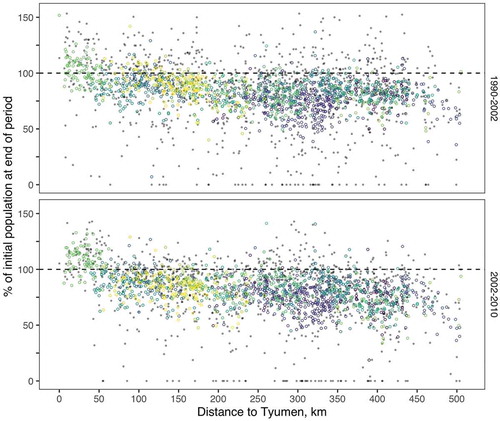
Figure A2.1. Actual and predicted (RIRS model) values against distance to rayon centers
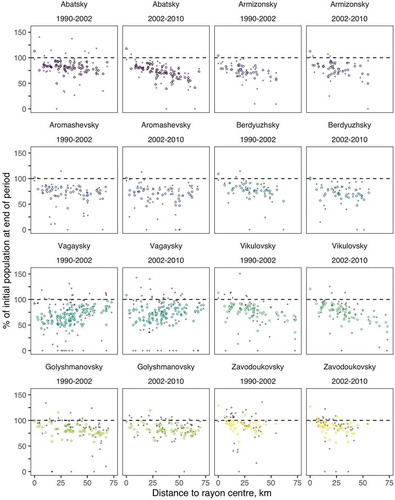
Figure A2.2. Actual and predicted (RIRS model) values against distance to rayon centers
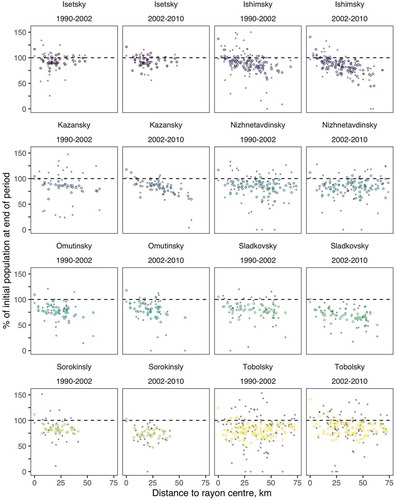
Figure A2.3. Actual and predicted (RIRS model) values against distance to rayon centers
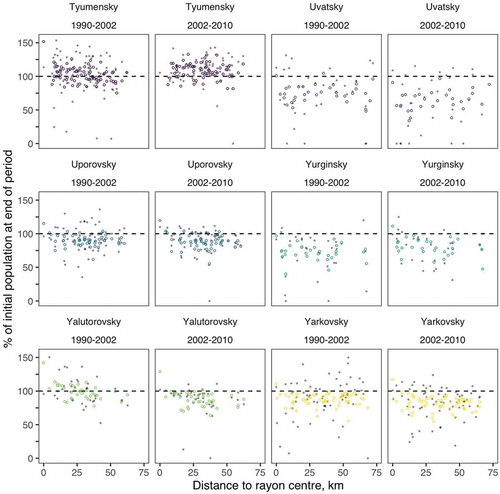
Figure A4. Structural changes in cattle farming in Tyumen province in 1990–2010
